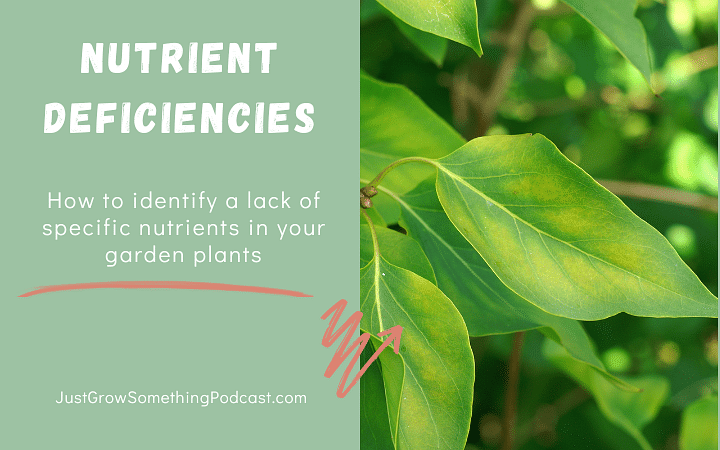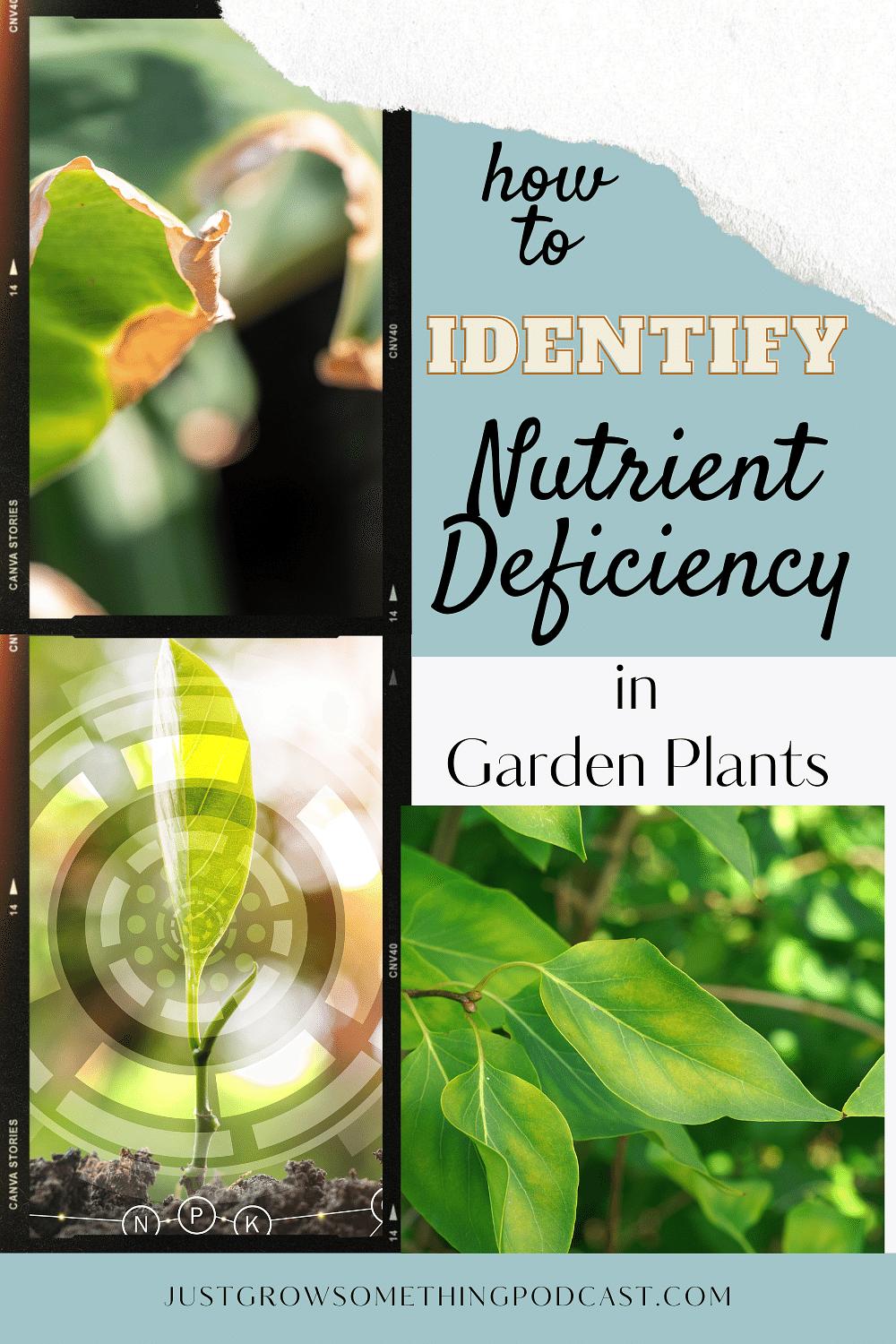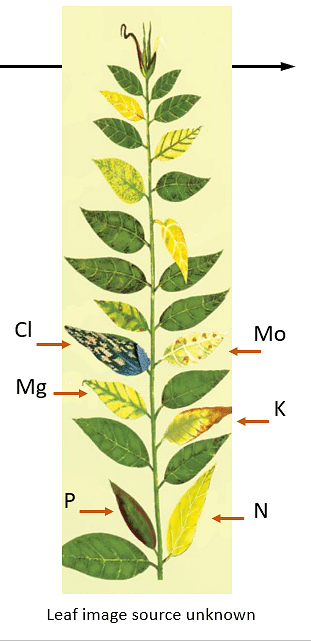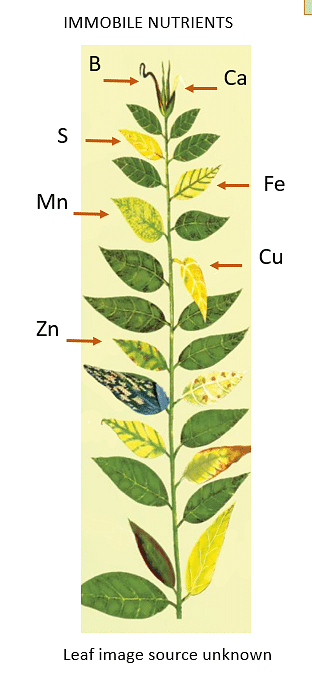
All plants need 16 essential nutrients for ideal growth. A few of these are macronutrients, the ones the plants need the most. Many are secondary or micronutrients, needed in lesser amounts but that are just as important. If our plants don’t get what they need they’ll tell us. We just have to know what to look for.
 Different nutrient deficiencies or toxicities are expressed in the plant in different ways. The first thing to notice is whether the changes are in the new leaves or the older leaves. This tells you whether or not that nutrient is mobile. If it is mobile and there is a deficiency, the plant will move the nutrient out of the older leaves into the new leaves to protect the new growth, so the symptoms will be expressed in the older leaves first, generally the lower-most leaves on the plant. Conversely, if the nutrient is not mobile in the plant the symptoms will show up first in the new leaves, or the uppermost leaves. Knowing this will give you a starting point when diagnosing nutrient problems.
Different nutrient deficiencies or toxicities are expressed in the plant in different ways. The first thing to notice is whether the changes are in the new leaves or the older leaves. This tells you whether or not that nutrient is mobile. If it is mobile and there is a deficiency, the plant will move the nutrient out of the older leaves into the new leaves to protect the new growth, so the symptoms will be expressed in the older leaves first, generally the lower-most leaves on the plant. Conversely, if the nutrient is not mobile in the plant the symptoms will show up first in the new leaves, or the uppermost leaves. Knowing this will give you a starting point when diagnosing nutrient problems.
 Nitrogen, Phosphorous, Potassium, and Magnesium are all mobile. So, deficiencies in these nutrients are more likely to show up in older leaves first.
Nitrogen, Phosphorous, Potassium, and Magnesium are all mobile. So, deficiencies in these nutrients are more likely to show up in older leaves first.
Symptoms of nitrogen deficiency include stunted plant growth, an overall pale look to older leaves with just generalized yellowing evenly throughout the leaf, or older leaves that stand unusually upright while displaying a sickly greenish/yellowish color.
Phosphorous deficiency generally will manifest itself in purpling of leaves. This can be immediately obvious specifically on tomato plants. If you have necrosis, or death of parts of both the old and the new leaves, specifically at the tips or edges of the leaves, this can also indicate a phosphorous deficiency.
Potassium deficiency can manifest as necrosis or dying off of the old leaves or yellowing of those older leaves but only in the space between the veins (interveinal chlorosis). In more severe cases, it will begin to affect the new leaves too with curled under and wilted leaves, both old and new, as well as small, stunted leaves. Severe deficiencies will also appear as severely wrinkled new leaves.
Too little magnesium can cause the older leaves on the plant to develop dead blotchy patches as well as interveinal chlorosis, that yellowing between the veins. It can also cause both the old and new leaves to begin to curl over.
What about nutrients that aren’t mobile in the plant? The most common deficiencies for these around found with sulfur, calcium, boron, and zinc.
 Indicators of sulfur deficiency include uniform yellowing of the leaves, distinctly where the leaf surface is yellow and the veins are more a pale green, or small, stunted leaves.
Indicators of sulfur deficiency include uniform yellowing of the leaves, distinctly where the leaf surface is yellow and the veins are more a pale green, or small, stunted leaves.
Calcium deficiencies could be indicated by dying tips or edges of new leaves with a scorched appearance, dropping of the flower buds, irregularly shaped leaves and, of course, blossom-end rot on your fruits. It’s not unusual for there to be plenty of calcium in the soil but to have some environmental or nutritive reason for a plants inability to take it up, irregular watering being a main culprit. Before you assume blossom-end rot is being caused by low soil calcium, do a soil test.
With a boron deficiency you’ll see dead blotches on the new leaves, dropping of flower buds and a red or purple discoloration to the new leaves. So, old leaf purpling is phosphorous, new leaf purpling is likely boron. Boron deficiency will also cause irregularly shaped leaves.
Zinc deficiency is a little unique in that its symptoms are, quite literally, all over the place. You’ll see yellowing of both the old and the new leaves, you’ll get small, stunted old leaves at the same time as getting wrinkled and irregularly shaped new leaves.
There are very nuanced differences between each of the symptoms when you’re actually looking at the plant. Here are links to two really great flow charts to help you identify the problem, with good graphics for the leaf symptoms:
Mobile nutrients: DefFlowChartMobile.png (montana.edu)
Immobile nutrients: DefFlowChartImmob.png (montana.edu)
Also, take into consideration other environmental factors, like cold snaps or heat waves, too much water or not enough. All of these environmental events can cause temporary symptoms that mimic many of the symptoms of nutrient deficiencies.
Many times, figuring out plant problems isn’t cut and dry, which is why it’s always good to have a soil test done before the season starts and to keep track in a garden journal what amendments and fertilizers you have added so you have an idea of where to start.
Your friend in the garden,

